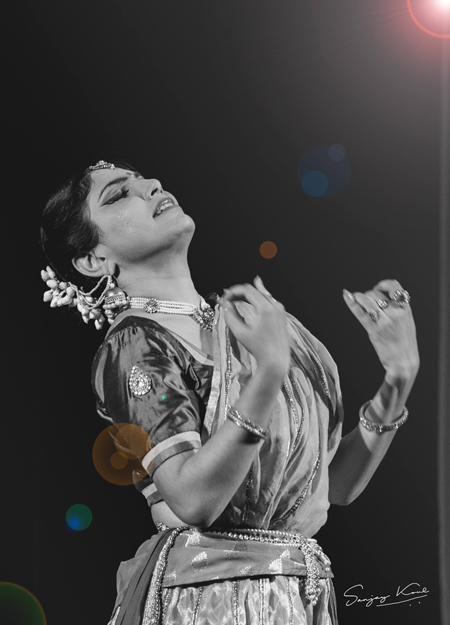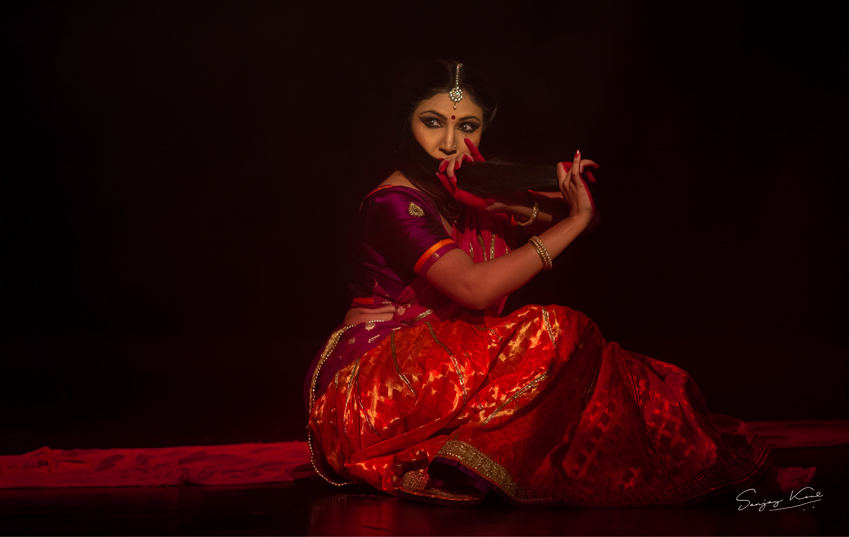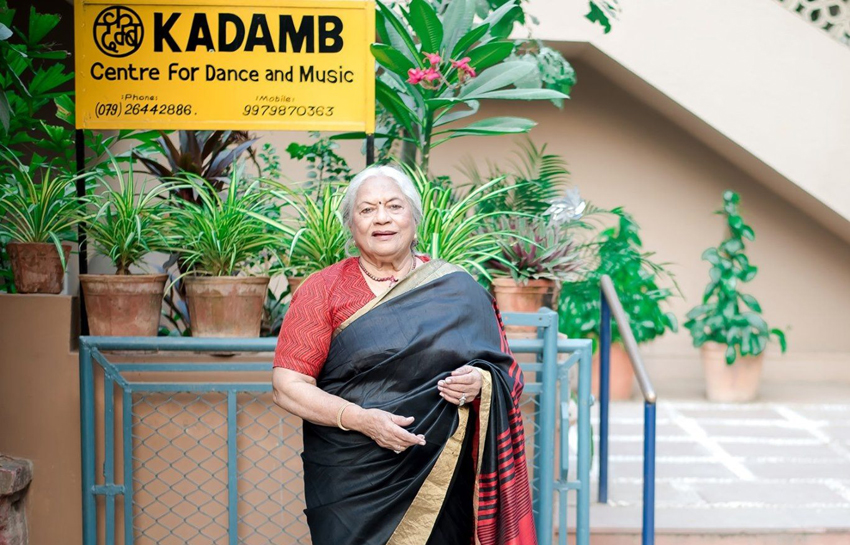Yagyaseni, by Kathak danseuse Sangita Chatterjee, offered hope for a strong emerging Kathak soloist. The adapted award-winning novel as a dance theatre captured an audience of almost 350 in New Delhi for a full one hour fifteen minutes.
It was unusual, that the Stein Auditorium, Habitat Centre, New Delhi, having a capacity of about 400 seats was nearly full on a sultry September evening. It was even more surprising that the performance as a dance theatre was by a lesser-known solo Kathak artist – Sangita Chatterjee.
Based on the Gyanpeet Award fiction ‘ Yagyaseni’ by Odiya writer by Dr. Pratibha Ray, the novel was adapted as a dance theatre in Kathak Classical dance. The story was on and the point of view of Draupadi. To adapt a literary piece in dance is always a challenge. However, dancer Sangita Chatterjee lived beyond expectations. She performed myriads of emotions asserting the point of view of one of the central character in one of the world’s most complex epics. The sheer attempt to do so required not only an educated mind but also sensitivity on different levels to have a grip on unfolding the character of the protagonist.
The Surprise – Kathak can be more than Chakkers
In the present scenario, where Kathak dance group of a solo is defined by sheer virtuosity, and gimmickry of technology, the dance theatre by Sangita Chatterjee was different. First of all, the spins were there only when required and the beautiful lighting at least showed the artist’s face; normally the designer lighting takes over Kathak performances, and one view only robotic figures, with hidden faces moving around the stage listlessly, sub-standard Kathak dance hidden behind some kind of mysterious storyline. “I do not like Kathak, it appears that there are only chakkars (spins) and acrobatic almost mechanical movements as if ghosts are moving around!” said Ritu Mitra a young dancer specializing in contemporary dance. “However, I took a chance and came to see the program as a Kathak production, and was unable to leave my seat. There was the best use of lighting and so much of emotional appeal. It was intense, it was powerful.”
The Story and Content
The story began with the younger Dhraupadi born out of the sacrificial fire. Her strength of character gradually evolved in her equation with Krishna.
She is Krishnaaa (the dark one) and so his her companion Krishna. He is her ‘Sakha’ – friend, guide, protector. From questioning her existence, Sangita Chatterjee strung together the gradual becoming of Dhraupadi as ‘Yagyaseni’.
The delightful young Dhraupadi dallying with nature got intertwined with images of Krishna who captures her mind. The shift to the story moved forward, with a beautiful rendition of creating the flow of the peacock feather on the head on Krishna. From there onward, the young girl moves in life to be married, to her humiliation in the court of Hastinapur. Crisply executed the scenes moved seamlessly. One hour fifteen minutes, Chatterjee did not leave the stage for a moment.
Dramatic assessment of the self with the use of stage properties -such as the use of a curtain, a screen in dialogue with the shadow of the protagonist along with skilful lighting added to the perfect dance.
It was a performance that kept in view the technical nuances of the Kathak dance. The clarity in the footwork which was moderated to suit the storyline, along with technical piece was executed with care and thankfully were not jarring. The light design by Sharad Kulasrestha was complimentary to the dance; fortunately, neither the light, sets, nor music (by Saroj Mohanty) did not take over the dance but rather assisted the story to evolve. Other accessories were adroitly used, for example, the use of a long red cloth brought out not one but the dual metaphor not only the disrobing of Draupadi but also the element of blood that goes with the story of her life.

For someone as young as Sangita, it was rather creditable to have successfully attempted such a complex theme. Her education, as well as her sensitivity, were ideally displayed. It is rather and often disappointing that the lack of formal education among Kathak dancers reflect in their works especially that which have to do with Natya or dramatic element. Either Kathak dramatic compositions get limited to myths with no comprehension of the symbolic layering of the ideas; or recently, one sees Kathak dancers picking esoteric abstract poetic pieces of Sufism, nirguna poets like Nanak, or Kabir again without truly understanding the in-depth cultural idiom of the poetry.
Yagyaseni was indeed a surprise, meticulously done, the script lyrics by Himanshu Srivastava, script by Averee Chaurey and Sangita herself; one hopes the young dancer works even harder as she proceeds to build herself as a hopeful and emphatic Kathak soloist!








